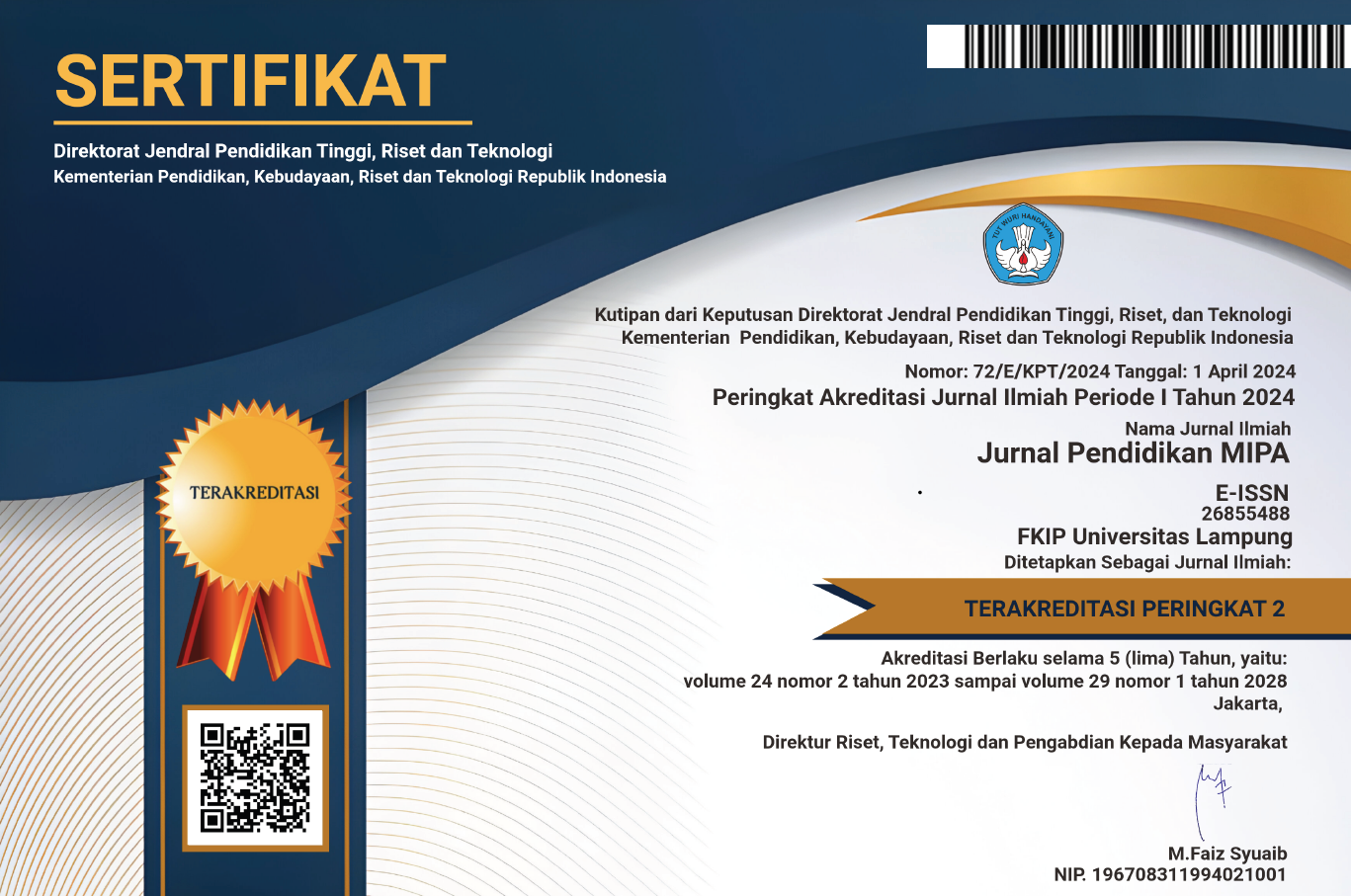Math-Oriented Critical Thinking Skills of Elementary School Students Viewed from Cognitive Style
(1) Universitas Muhammadiyah Gresik, Indonesia
(2) Universitas Muhammadiyah Gresik, Indonesia
(3) Universitas Muhammadiyah Gresik, Indonesia
Copyright (c) 2022 Syaiful Huda, Fatimatul Khikmiyah, Vina Melindah
| Article Metrics→ |
| Indexing Database→ |
Abstract
The tendency to develop critical thinking skills has been carried out for a long time starting from the definition, indicators of mathematical critical thinking, and the practice of developing critical thinking. Critical thinking can be developed both individually and classically through learning. The purpose of this study was to analyze qualitatively the mathematical critical thinking process of SD Muhammadiyah Manyar students in terms of cognitive style. The research method is descriptive qualitative. The results of the analysis obtained students with FD cognitive style more than students with FI cognitive style. From the difference in numbers, it is in line with the analysis of the learning process where students need more teacher instruction in completing assignments. In addition, from the analysis of critical thinking aspects according to Facione (2013) of the 6 existing aspects there are 2 aspects that have not been achieved by students, namely explanation and self-regulation.
Keywords: critical thinking skills, cognitive style, elementary school.
References
Tentu, ini daftar pustaka kedua yang sudah saya rapikan:
Abrami, P. C., Bernard, R. M., Borokhovski, E., Wade, A., Surkes, M. A., Tamim, R., & Zhang, D. (2008). Instructional Interventions Affecting Critical Thinking Skills and Dispositions: A Stage 1 Meta-Analysis. Review of Educational Research, 78(4), 1102–1134.
Abrami, P. C., Bernard, R. M., Borokhovski, E., Waddington, D. I., Wade, C. A., & Persson, T. (2014). Strategies for Teaching Students to Think Critically: A Meta-Analysis. Review of Educational Research, 84(4), 1–40.
Abrami, P. C., Bernard, R. M., Borokhovski, E., Waddington, D. I., Wade, A. C., & Persson, T. (2015). Strategies for teaching students to think critically: A meta-analysis. Review of Educational Research, 85(2), 275–314.
Akbıyık, C., & Seferoğlu, S. S. (2006). Eleştirel düşünme eğilimleri ve akademik başarı [Critical thinking dispositions and academic achievement]. Çukurova Üniversitesi Eğitim Fakültesi Dergisi, 3(32), 90–99.
Association of American Colleges and Universities. (2005). Liberal education outcomes: A preliminary report on student achievement in college. Liberal education. Washington, DC: AAC&U.
Broadbear, J. T., & Keyser, B. B. (2000). An approach to teaching for critical thinking in health education. Journal of School Health, 70(8), 322–326.
Loes, C. N., & Pascarella, E. T. (2017). Collaborative Learning and Critical Thinking: Testing the Link. The Journal of Higher Education, 88(5), 726–753.
Ennis, R. H. (1985). A logical basis for measuring critical thinking skills. Educational Leadership, 43(2), 44–48.
Facione, P. A. (2011). Measured Reasons and Critical Thinking. Lillbrae, CA: The California Academic Press.
Hirose, S. (1992). Critical thinking in community colleges. ERIC Clearinghouse for Junior College s Los Angeles CA. (ERIC Document Reproduction Service No: ED348128).
Kemdikbud. (2017). Materi Pendukung Literasi Numerasi [Numeracy Literacy Support material]. Jakarta: Tim GLN.
Radulovic, L., & Stancic, M. (2017). What is Needed to Develop Critical Thinking in Schools. CEPS Journal, 7(3), 9–25.
Uribe-Enciso, O., Uribe-Enciso, D., & Vargas-Daza, M. (2017). Critical thinking and its importance in education: some reflections. Rastros Rostros.
Lin, S.-S. (2014). Science and non-science undergraduate students’ critical thinking and argumentation performance in reading a science news report. International Journal of Science and Mathematics Education, 12(5), 1023–1046.
Maricic, S., & Špijunovićb, K. (2015). Developing Critical Thinking in Elementary Mathematics Education through a Suitable Selection of Content and Overall Student Performance. Procedia - Social and Behavioral Sciences, 180, 653–659.
National Research Council. (1996). National science education standards. Washington, DC: National Academy Press.
Paul, R., & Elder, L. (2009). The miniature guide to critical thinking-concepts and tools (Thinker’s guide). Dillon Beach, CA: Foundation for critical thinking.
Pascarella, T., & Terenzini, P. (2005). How College Affects Students, A Third decade of Research (2nd ed.). San Francisco: Jossey-Bass.
Permendikbud. (2013). Peraturan menteri pendidikan dan kebudayaan republik Indonesia nomor 81 A tahun 2013 tentang implementasi kurikulum pedoman umum pembelajaran [Regulation of the Minister of Education and Culture of the Republic of Indonesia number 81 A of 2013 concerning the implementation of curriculum general guidelines for learning].
Santos, L. F. (2017). The Role of Critical Thinking in Science Education. Journal of Education and Practice, 8(20), 160–173.
Parsons, T. (1978). Sociology. Alfred A Knopf. New York.
ten Dam, G., & Volman, M. (2004). Critical thinking as a citizenship competence: Teaching strategies. Learning and Instruction, 14(4), 359–379.
Uno, H. B. (2006). Orientasi dalam Psikologi Pembelajaran [Orientation in Learning Psychology]. Jakarta: Bumi Aksara.
Witkin, H. A., Oltman, P. K., Raskin, E. (1971). Manual Embedded Figures Test, Children Embedded Figures Test, Group Embedded Figures Test. Consulting Psychology Press, Inc. California.
Witkin, H. A., Moore, C. A., Goodenough, D., & Cox, P. W. (1977). Field-Dependent and Field-Independent Cognitive Styles and Their Educational Implications. Review of Educational Research, 47(1), 1–64.
Woolfolk, A. E. (1993). Educational Psychology (5th ed.). Singapore: Allyn and Bacon.
ŽivkoviĿ, S. (2016). A Model of Critical Thinking as an Important Attribute for Success in the 21st Century. Procedia - Social and Behavioral Sciences, 232, 102–108.
Refbacks
- There are currently no refbacks.

This work is licensed under a Creative Commons Attribution-ShareAlike 4.0 International License.

The copyright is reserved to The Jurnal Pendidikan MIPA that is licensed under a Creative Commons Attribution-ShareAlike 4.0 International License.


